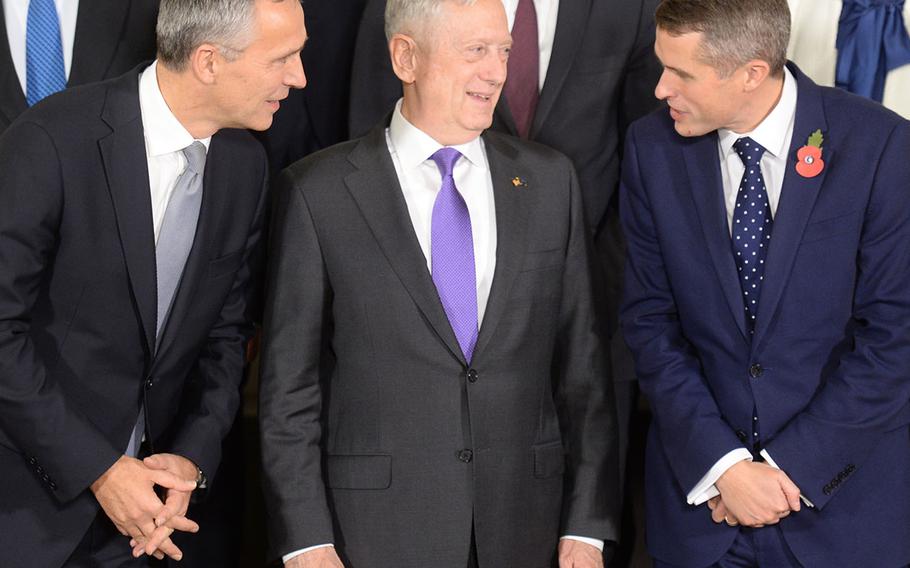
Left to right: NATO Secretary General Jens Stoltenberg, left, with U.S. Secretary of Defense Jim Mattis and UK Minister of Defence Wednesday, Nov. 8, 2017 at Brussels. (NATO)
The United States and its military allies in Europe agreed Wednesday to establish a new cyber command center that will allow NATO to incorporate electronic weaponry in its operational planning, the alliance’s top official said.
The decision comes at a time of growing concern over Russian cyber intrusions and meddling such as a recent string of attacks on U.S. troops operating in Poland who have had their smartphones hacked while on deployment, according to U.S. military officials.
NATO Secretary-General Jens Stoltenberg said allies agreed to establish a new cyber operations center as part of an overhaul of NATO’s command structure.
“We must be just as effective in the cyber domain as we are on land, at sea and in the air, with real-time understanding of the threats we face and the ability to respond however and whenever we choose,” Stoltenberg said at the start of a two-day defense ministers conference in Brussels.
During the meeting that included Defense Secretary Jim Mattis, allies agreed national cyber capabilities can be incorporated into NATO missions and operations. It amounts to a step forward for the 29-nation alliance, which has decades of experience conducting conventional military operations, but is less experienced in the cyber realm.
Stoltenberg said a cyber response to a potential attack could be more proportional than traditional military means.
“For NATO, it is always the aim to use minimum force to achieve maximum effect,” he said.
For two years, NATO has been moving toward a more robust cyber operation.
In 2016, the alliance formally designated the cyber domain as a new front line, adding virtual attacks as an area that could demand a collective Article 5 military response much like a conventional assault from land, air or sea.
Article 5 serves as a linchpin for NATO, asserting a major attack on one member state demands a collective response from the military alliance.
In February, allies approved an updated cyber defense plan with cyber “rapid reaction” teams intended to help allies better defense against an array of unconventional hybrid attacks. In 2016, NATO experienced an average of 500 cyber intrusions per month, an increase of 60 percent from the previous year.
NATO’s long-standing tactical advantage on the battlefield could be at risk as cyber adversaries probe for weak points in the U.S.-led security pact’s networks, NATO officials have warned.
As expected, allies on Wednesday also approved a plan to begin work setting up two new commands designed to ensure American reinforcements can safely cross the Atlantic Ocean during a time of crisis and maneuver throughout Europe with greater speed.
The new commands harken to the Cold War, when there were roughly 30,000 troops stationed at 30 different NATO commands. That number has dwindled to about 7,000 personnel working at seven NATO commands as security concerns faded in Europe.
NATO’s efforts to rebuild command and control systems is a response to concerns about a more aggressive and unpredictable Russia.
NATO also will work more closely with the European Union to ensure roads, bridges, rail lines and other public and commercial infrastructure are capable of managing the flow of tanks and other equipment throughout Europe. Allies are working to reduce “bureaucratic hurdles” to allow the alliance to move forces more freely across allied territory, Stoltenberg said.
“But much more needs to be done,” he said.
vandiver.john@stripes.com Twitter: @john_vandiver